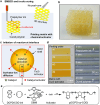Multimaterial 3D Printing in Activating Bath Enables In Situ Polymerization of Thermosets with Intricate Geometries and Diverse Elastic Behaviors
- PMID: 40801338
- PMCID: PMC12574649
- DOI: 10.1002/adma.202508568
Multimaterial 3D Printing in Activating Bath Enables In Situ Polymerization of Thermosets with Intricate Geometries and Diverse Elastic Behaviors
Abstract
Polydicyclopentadiene, p(DCPD), is a high-performance thermoset valued for its exceptional toughness, strength, and stiffness. When copolymerized with 1,5-cyclooctadiene (COD), its mechanical properties can be tuned from glassy to rubbery at room temperature. While frontal polymerization enables a rapid and energy-efficient route to 3D print DCPD-based materials, challenges such as ink shelf life and gravitational distortion, especially in direct ink writing of soft COD-rich formulations, must be considered. Here, a complementary chemical strategy is presented, embedded 3D printing, that enables localized in situ polymerization of printed DCPD/COD inks within a reactive support matrix. The matrix provides both physical support and a reservoir of chemical activator, which diffuses into the ink, activates a latent bis(N-heterocyclic carbene) Ru precatalyst, and initiates ring-opening metathesis polymerization. Curing begins at the ink-matrix interface and propagates inward via diffusion, stabilizing the interface and preventing capillary-driven deformation regardless of the matrix yield stress. This approach eliminates the need for cold storage, external curing, or photoinitiation, significantly expanding the processing window. Using this method, diverse thermosetting and elastomeric architectures are fabricated with features as small as 5 µm and aspect ratios of 100, including interlinked chains, shallow spherical shells exhibiting snap-through buckling, and hair-like fin arrays inaccessible through traditional techniques.
Keywords: chemical activation; elastomer; embedded 3D printing; ring opening metathesis polymerization; thermoset.
© 2025 The Author(s). Advanced Materials published by Wiley‐VCH GmbH.
Conflict of interest statement
The authors declare no conflict of interest.
Figures





References
-
- Alo O. A., Mauchline D., Otunniyi I. O., Adv. Eng. Mater. 2022, 24, 2101219.
-
- Saadi M. A. S. R., Maguire A., Pottackal N. T., Thakur M. S. H., Ikram M. M., Hart A. J., Ajayan P. M., Rahman M. M., Adv. Mater. 2022, 34, 28. - PubMed
-
- Raquez J. M., Deléglise M., Lacrampe M. F., Krawczak P., Prog. Polym. Sci. 2010, 35, 487.
-
- Friedrich K., Almajid A. A., Appl. Compos. Mater. 2013, 20, 107.
Grants and funding
- DE-AR0001330/U.S. Department of Energy, Advanced Research Projects Agency-Energy
- SC0023457/Regenerative Energy-Efficient Manufacturing of Thermoset Polymeric Materials (REMAT) Energy Frontier Research Center funded by the U.S. Department of Energy Office of Science Basic Energy Sciences
- Kwanjeong Educational Foundation
LinkOut - more resources
Full Text Sources
Miscellaneous

